page 4
(The Study of Threes)
http://threesology.org

|
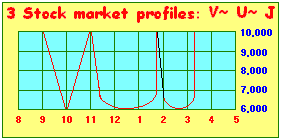
3 Stock Market Profiles: V ~ U ~ J
3 big stock exchanges in the U.S.:
- NYSE (New York Stock Exchange)
- AMEX (American Stock Exchange)
- NASDAQ (National Association of Securities Dealers)
3 frequently used stock indices: DOW ~ NASDAQ ~ S & P
3 categories of stock indices: Close ~ Change ~ % (percentage)
3 stockbroker actions: Buy ~ Sell ~ Hold
3 best months of the S & P (Standard and Poor's index): November - December - January
3 Note divisions:
- 5 year note
- 10 year note
- 30 year note
3-patterned references included in some concepts of the Dow theory of Technical Analysis:
- The Averages Discount Everything.
- The Market Is Comprised of Three Trends.
- Primary Trends Have Three Phases.
- The Averages Must Confirm Each Other.
- The Volume Confirms the Trend.
3-patterned Technical Analysis based on the Elliott Wave Theory of Market Timing breaks down impulse waves and corrective waves into five primary and three primary movements respectively. The eight movements comprise a complete wave cycle. Time frames can range from 15 minutes to decades:
3-patterned Fibonacci numbers sequence is used as a tool (in conjunction with other techniques) by many Wall Street Analysts in their trading strategies:
History:
Leonardo Fibonacci, a mathematician in the 1200’s created a numerical sequence of numbers. From left to
right after the first two numbers, the (3rd number) values increase successively. Each (third) number, in turn, is determined by the sum of the previous two
numbers:
to get the next value of Fibonacci series after 377 add 233 to 377 and arrive at 610.
The other interesting relationship of this number sequence is that if we take the ratio of two successive numbers in the Fibonacci series (that is, we divide each number by the number after it in the sequence) we will move towards a particular constant value. That value is 0.6180345 which has been referred to as "the golden ratio". If you also calculate the ratios using alternate numbers in the Fibonacci series (that is, do the same calculation but skip over a number) the resulting ratios approach e 0.38196
Numerologically speaking, if you add the numbers (0.6 + 1 + 8 + 0 + 3 + 4 + 5) and/or (0.3 + 8 + 1 + 9 + 6), you get the number 9, separately, or 18 together, which is 1 + 8 = 9. The number 9 is called the perfect number because it is 3 X 3 or three 3s.
Many technicians use Fibonacci numbers in their Technical Analysis when trying to determine support and resistance, and commonly use:
- 38.2%
- 50%
- 61.8%
...known as retracements. Commonly thought, a .382 retracement from a trend move will tend to imply a continuation of the trend. A .618 retracement implies that a trend change may be in the making. Many such rules have been adopted by technicians.
Note: the Fibonacci numbers series is found in the sequencing of leaves on plants.
The hour before the stock market closing on the third Friday of March, June, September, or December, when both options and futures on stock indices expire, known for its high trading volume and volatile prices in futures, options, and underlying securities.
Triple, Double (and Single?) witching:
Joe Dunhill Senior Market Analyst It might sound like something out of MacBeth, but Triple Witching Friday is actually a term applied to a significant financial event than can impact your investing strategy. Most sophisticated investors use options to enhance their portfolio returns, or employ the use of options to reduce the risk of their investments loosing value over time. An option is essentially a contract to purchase a security at a fixed price. There are basically three types of options:
Under the option agreement, all of the above options expire after a set time period. The expiration of these options is set for the third Friday in a pre-determined month. Because of the nature of our Roman Calendar, expiration Friday for one class of option may coincide with the expiration of another class of option. When two classes of options share a common expiration Friday, that Friday is called Double Witching Friday, or simply "Double Witch." When all three classes of Options share the same expiration Friday, it is called Triple Witching Friday, or simply-Triple Witch". The investor needs to realize that sophisticated traders, portfolio managers and hedge fund managers compose complex money making strategies and schemes. These complex financial plans are subject to market unknowns, and therefore managers engineer alternative scenarios that limit their downside risk. A considerable ingredient in these financial plans is options management and manipulation. The design and manufacturing of these complex plans is called "Winding a position". Like a watch spring, these plans have engineered into them potential financial energy which may either be enhanced or weakened over time as economic conditions ebb and flow throughout the market cycle. Because options expire at a given time, financial managers are under the gun to either engage a certain tack or close and abandon a certain tack. This requires closing a position or covering a position in options. When an options position is "closed" or "covered," it is called "un-winding a Position". Triple Witch Friday’s will therefore experience significantly more market action and volume because managers un-wind their positions in expectation of options expiring. In fact, the action of un-winding positions may take place over a number of days prior to a Friday on which options are set to expire. Investors need to realize that Triple Witch will influence the market in a variety of ways that may not appear to have any rational basis, and be prepared for the volatility. An astute investor will have Options Expiration Fridays inked in red on his/her calendar and be prepared for the ride and the hype. |
Markets move against the trend of one greater degree only with a seeming struggle. Resistance from the larger trend appears to prevent a correction from developing a full impulsive structure. The struggle between the two oppositely trending degrees generally makes corrective waves less clearly identifiable than impulsive waves, which always flow with comparative ease in the direction of the one larger trend. As another result of the conflict between trends, corrective waves are quite a bit more varied than impulsive waves.
Corrective patterns fall into four (3 to 1 ratio) main categories:
- 1 of 3. Zigzags (5-3-5; includes three variations: single, double, triple);
- 2 of 3. Flats (3-3-5; includes three variations: regular, expanded, running);
- 3 of 3. Triangles (3-3-3-3-3; four types: ascending, descending, contracting, expanding);
- 1 of 1. Double threes and triple threes (combined structures).
ZIGZAGS (5-3-5)
A single zigzag in a bull market is a simple three-wave declining pattern labeled A-B-C and subdividing 5-3-5. The top of wave B is noticeably lower than the start of wave A, as illustrated in Figures 11 and 12.
Occasionally zigzags will occur twice, or at most, three times in succession, particularly when the first zigzag falls short of a normal target. In these cases, each zigzag is separated by an intervening "three" (labeled X), producing what is called a double zigzag (see Figure 13) or triple zigzag. The zigzags are labeled W and Y (and Z, if a triple).
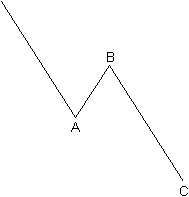 Figure 11 Figure 11 |
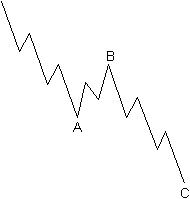 Figure 12 Figure 12 |
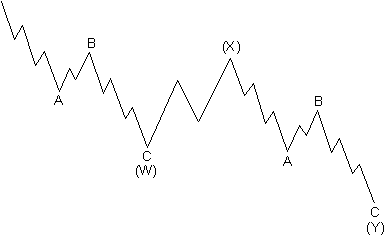
FLATS (3-3-5)
A flat correction differs from a zigzag in that the subwave sequence is 3-3-5, as shown in Figures 14 and 15. Since the first actionary wave, wave A, lacks sufficient downward force to unfold into a full five waves as it does in a zigzag, the B wave reaction seems to inherit this lack of counter-trend pressure and, not surprisingly, terminates near the start of wave A. Wave C, in turn, generally terminates just slightly beyond the end of wave A rather than significantly beyond as in zigzags.
Flat corrections usually retrace less of preceding impulse waves than do zigzags. They participate in periods involving a strong larger trend and thus virtually always precede or follow extensions. The more powerful the underlying trend, the briefer the flat tends to be. Within impulses, fourth waves frequently sport flats, while second waves rarely do.
Three types of 3-3-5 corrections have been identified by differences in their overall shape. In a regular flat correction, wave B terminates about at the level of the beginning of wave A, and wave C terminates a slight bit past the end of wave A, as we have shown in Figures 14 and 15. Far more common, however, is the variety called an expanded flat, which contains a price extreme beyond that of the preceding impulse wave. In expanded flats, wave B of the 3-3-5 pattern terminates beyond the starting level of wave A, and wave C ends more substantially beyond the ending level of wave A, as shown in Figures 16 and 17.
In a rare variation on the 3-3-5 pattern, which we call a running flat, wave B terminates well beyond the beginning of wave A as in an expanded flat, but wave C fails to travel its full distance, falling short of the level at which wave A ended. There are hardly any examples of this type of correction in the cord.
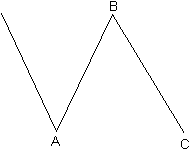 Figure 14 Figure 14 |
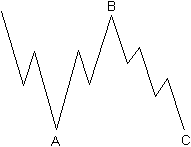 Figure 15 Figure 15 |
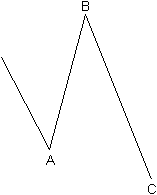 Figure 16 Figure 16 |
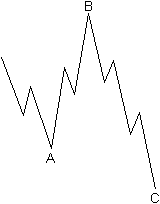 Figure 17 Figure 17 |
Triangles are overlapping five wave affairs that subdivide 3-3-3-3-3. They appear to reflect a balance of forces, causing a sideways movement that is usually associated with decreasing volume and volatility. Triangles fall into four main categories as illustrated in Figure 18. These illustrations depict the first three types as taking place within the area of preceding price action, in what may be termed regular triangles. However, it is quite common, particularly in contracting triangles, for wave b to exceed the start of wave a in what may be termed a running triangle, as shown in Figure 19.
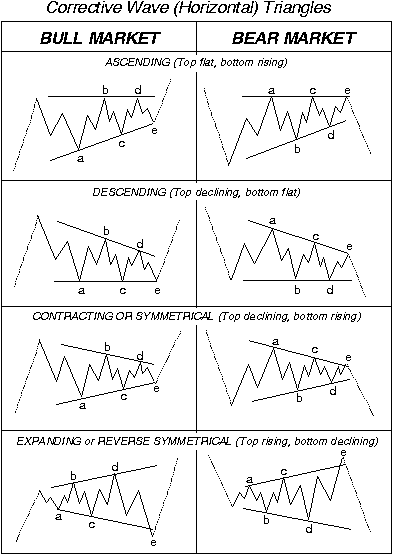
Figure 18
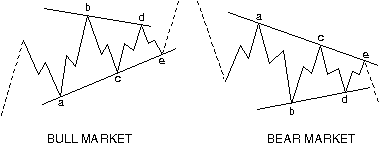
Figure 19
Although upon extremely rare occasions a second wave in an impulse appears to take the form of a triangle, triangles nearly always occur in positions prior to the final actionary wave in the pattern of one larger degree, i.e., as wave four in an impulse, wave B in an A-B-C, or the final wave X in a double or triple zigzag or combination (see next section).
Elliott called sideways combinations of corrective patterns "double threes" and "triple threes." While a single three is any zigzag or flat, a triangle is an allowable final component of such combinations and in this context is called a "three." A double or triple three, then, is a combination of simpler types of corrections, including the various types of zigzags, flats and triangles. Their occurrence appears to be the flat correction's way of extending sideways action. As with double and triple zigzags, each simple corrective pattern is labeled W, Y and Z. The reactionary waves, labeled X, can take the shape of any corrective pattern but are most commonly zigzags. Figures 20 and 21 show two examples of double threes.
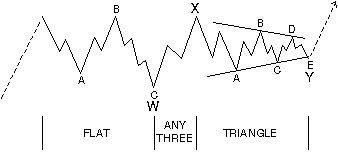
Figure 20
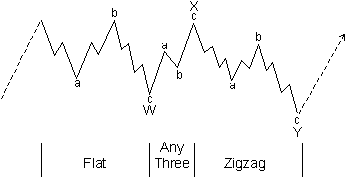
Figure 21
For the most part, double threes and triple threes are horizontal in character. One reason for this trait is that there is never more than one zigzag in a combination. Neither is there more than one triangle. Recall that triangles occurring alone precede the final movement of a larger trend. Combinations appear to recognize this character and sport triangles only as the final wave in a double or triple three.
All the patterns illustrated here take the same form whether within a larger rising or falling trend. In a falling trend, they are simply inverted.
3-patterned triangle reference labeled "pennant":
A pennant is a (triangular) pattern where the stock has narrowing highs and lows as it moves sideways, converging more or less on the centerline between the highs and lows. Think of it as a cone turned on its side. We prefer to see volume fall as the pattern tightens. Stocks can break either up or down from pennants (wedges are much more bullish), and we have to see a stock make the move over the recent highs before taking a position. They can fool you. You think it is breaking down right at the end, but then shoots up-pennants often shake out the weak holders right at the end before they shoot up. Investors know they can break down, and bail if it gets them in trouble. Then it shoots up on them. That is why we wait for the break up-it helps us keep our emotions in check and from making an emotional choice.
Three divisions of the NYSE (New York Stock Exchange) Regulation:
- Member Firm Regulation, responsible for the financial, operational and sales-practice regulation of member organizations.
- Market Surveillance, responsible for surveillance of all trading activities at the Exchange.
- Enforcement, which investigates and prosecutes violators of NYSE rules and federal securities laws.
There are approximately 560 people in NYSE Regulation, representing approximately one-third of the Exchange's staff.
Three categories Investors tend to fall into:
- Disciples of Ricardo: The law of comparative advantage, as first described by Ricardo, guarantees an optimal distribution of labor and capital between countries, and thus a very good growth rate for profits. This is true as long as comparative advantages have not been fully exploited. And, of course, the one part of the world where Ricardo's law of comparative advantages is just beginning to have an impact is, of course, emerging markets (for example, see The Bullish Growth in China's Road Infrastructure). Thus, 'Ricardian investors' tend to be very biased today towards emerging markets.
- Disciples of Schumpeter: For Schumpeterians, the source of high returns can be found in the influence of the entrepreneur/inventor and breakthroughs in technology. Such investors tend to favor knowledge-based companies (we have called these platform-companies), and usually carry overweight position in tech stocks, healthcare stocks and other growth stocks.
- Disciples of Malthus: For such investors, commodities cannot not be in short supply over time given the growth of the world's population and of overall global incomes. Commodity prices will thus have to rise given that we are confronting a world with too many Chinese/Indians/Asians... and not enough oil/copper/gold/iron-ore etc... For Malthusians, the solution is thus simple: load up on commodities or commodities producers or load up on gold and stay outright bearish of most asset classes. Most of the perma-bears (as opposed to cyclical bears) we have met over the years tend to be disciples of Malthus.
Will the three trends of 2009 prevail in 2010
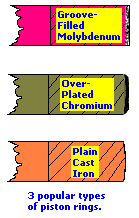
Three popular types of top compression ring face coatings each has advantages of its own with respect to operating conditions:
- Cast Iron- For typical light duty service where the vehicle Is not subjected to long periods of high speed or load operation and is run primarily on paved streets, plain cast iron is a good choice because piston ring cast iron is very durable when not subjected to unusual dirt or heat conditions.
- Moly (acronym for molybdenum)- When faced with continuous high speed or severe load conditions, the engine will be subjected to long periods of high temperatures. Moly Is then a good choice because of its scuff resistance. Moly is quite porous in its applied state which results in excellent retention of oil in the face of the ring. Moly also has the highest melting point of the three popular face coatings which results in its capability to live better under more severe operating conditions, or more specifically to resist scuffing and scoring.
- Chrome- In a dusty environment such as gravel pits, sand or rock mines, or operating on a dirt or unpaved roads, chrome is the best choice. Moly, because of its porosity, holds oil on the O.D. (outside diameter) face of the ring which helps inhibit scuffing. However, pores on the material also can serve as a trap for foreign materials. Because of the incoming air/fuel mixture probably will contain some abrasive contaminant. In a dusty environment, chrome with its smoother O.D. surface is a logical choice. Chrome's extreme density and hardness resists the Impingement of dirt into the face of the ring which accelerates cylinder wear, and actually contributes to the exhaust gases carrying some of the airborne contaminant out through the exhaust system. Chrome has more resistance to scuffing and scoring than cast iron but somewhat less than moly.
- 3 bolts used to secure the torque converter to the flex plate on small block chevy engines.
- 3 freeze plugs at the rear of small block chevy engines.
- 3 small (non-threaded) freeze plugs installed above the camshaft on the front of small block chevy engines.
- 3 threaded freeze plugs installed above the camshaft on the rear of small block chevy engines.
- 3 bolts secure the motor mount brackets to the sides of small block chevy engines.
- 3 bolts secure the timing chain sprocket to the camshaft on a small block chevy engine.
- 3 bolts secure the belt pulley to the harmonic balancer on a small block chevy engine.
- 3 bolts secure the belt pulley to the air pump on a small block chevy engine.
- 3 different sizes of bolts are used to secure the cylinder head of a small block Chevrolet engine.
3 rings are typically found on most gasoline combustion engine pistons:
- Top compression ring
- Second/middle compression ring
- Oil control ring.
3 common references to vehicle engine extractions:
- Engine hoist (some shops may prefer to say engine crane)
- Engine puller/pulley(s) (using chain, wire, or rarely rope)
- Cherry Picker (colloquial expression heard amongst older folks or young people who have been influenced by old mechanics.)
3 common variations of engine extractors:
- Homemade- usually of a solid or mobile/break-a-part "a-frame" (tripod) design.
- Manufactured- foldable, break-down, or break-a-part design.
- Manufactured- solid but mobile in the sense of being towable.
3 common "there's something in my eye" substances:
- Dust or dirt- (may be referred to sometimes as pollen).
- Hair from Eyelash- (though hair from one's head or eyebrow may also be encountered).
- Miscellaneous- (poking, jabbing, rubbing one's eye.)
Three Keys to Book Appraisal:
- The First Key: Demand- --- Book Collecting part 1 ---
- The Second Key: Scarcity- --- Book Collecting part 2 ---
- The Third Key: Condition- --- Book Collecting part 3 ---
The book collector's (3-part) mantra is "Condition, Condition, Condition."
Three Basic Book Repair Procedures
- Hinge Tightening 1- --- Book Arts Web-1 ---
- Hinge Tightening 2- --- Book Arts Web-2 ---
- Tipping-in loose pages- --- Book Arts Web-3 ---
3 colloquial references to the three common University degrees:
- B.S. = Bullsh!t
- M.S. = More of the Same
- Ph.D = Piled higher and deeper
3 to 1 ratio of criteria for the respiratory illness "SARS," as is currently defined (04-15-03) by the CDC (Center for Disease Control):
- 1 of 3. Fever of 100.4° X or higher;
- 2 of 3. Cough, shortness of breath, difficulty breathing, or abnormal chest x-ray.
- 3 of 3. Recent travel to Hong Kong; Guangdong Province in the People's Republic of China; Hanoi, Viet Nam; Singapore; or Toronto, Canada within 10 days of the onset of symptoms.
- 1 of 1. Close contact with a person with respiratory illness who is suspected of having SARS. Close contact
includes:
- Having cared for,
- Lived with, or
- Had direct contact with respiratory secretions or body fluids of a person with SARS. (Casual contact is unlikely to be a risk.)
Three types of "country" in the world:
- Aircraft country (airplane, balloon, hangglider, etc.)
- Off Road vehicles country (four-wheel drive, motorcycles, 3 or 4 wheelers)
- All the country in between (walking/hiking, camel, horse, elephant, etc.)
Updated Posting: Saturday, 17-June-2007... 4:26 PM
Latest Update: Friday, 1st November 2019... 1:48 PM
Herb O. Buckland
herbobuckland@hotmail.com